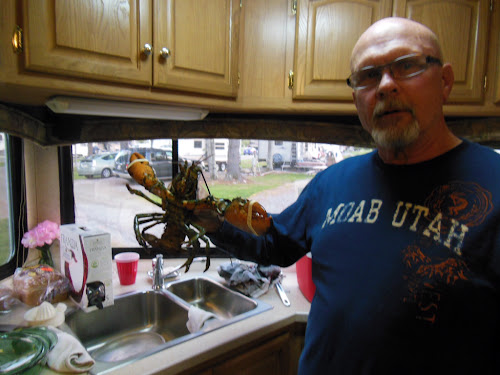We headed further east, to just about as far east as you can get without getting wet, at least in Nova Scotia. Actually the easternmost part of Nova Scotia is Cape Breton Island, reached by way of a causeway, so a ferry is not required to get there. We based ourselves in Baddeck, Nova Scotia because it's the start of the Cabot Trail, a 180 mile long scenic road that loops around the eastern end of Cape Breton Island. I think the road was oversold to us. Yes it's a beautiful drive, but Canada has a lot of trees and the trees block the views for the majority of the drive. We took some short side trips off of the Trail where we were rewarded with some great views. We had read that the roadway hugs the cliffs and might be uncomfortable for some. Whoever wrote that hasn't driven California's Highway 1. The road wasn't scary at all, with the exception of some Canadian sized potholes, which are plentiful in this part of country
The second reason for visiting Cape Breton was the Fortress of Louisbourg a Canadian National Historic Site. The Fortress of Louisbourg is the largest reconstruction project in North America. The original settlement was founded in 1713 by the French and developed over several decades into a thriving center for fishing and trade. Fortified against the threat of British invasion during the turbulent time of empire-building, Louisbourg was besieged twice before finally being destroyed in the 1760s. The site lay untouched until well into modern times, when archaeologists began to reconstruct the fortress as it was in the 18th century.
Today a visit to the Fortress is taking a walk back in time. The reconstructed fortress and it's buildings were rebuilt using some of the same methods utilized in the 1700's. Docents dressed in period costume stationed throughout the complex are there to answer questions and to do tasks in the same way as the first inhabitants.
Here in the garden and in other gardens in the complex, vegetables are grown and harvested. They are then used in the kitchen where meals are made and served to visitors. In trying to remain true to the times, many of the the varieties are genetically the same as the vegetables of the period. I was given a carrot to sample, and once getting past the grit, it was pretty flavorful.
This is the laundress who was trying to remove a stain from some cloth in the pot besides her. She told us that urine is a good stain remover. We'll have to try that when we get home.
This gentleman was repairing this Hurdy Gurdy and gave us a demonstration on how it's played. He was hand carving the replacement part. He said in real life he is a musical instrument repairman but has never had a Hurdy Gurdy brought into his shop.
Here at the hotel you can purchase a meal made from food produced in the Fortress, including turkey pie, pea soup and bread baked in wood fired ovens. We bought a loaf of bread from the baker. A soldier of the period got one loaf every 4 days. I tried to buy the bread at the going rate of the time, but they wouldn't go for my offer. Hey, they're the ones playing the 1700's game, so I figured the prices would be 1700 prices. Not so. The bread was really good though.
We opted not to eat at the fortress restaurant because we were finally giving in to the idea of Poutine. If you remember from the previous post, Poutine is a Canadian staple consisting of french fries smothered with gravy and cheese curds. It comes with other stuff too, if you desire. So, on the way back to camp we stopped in Sydney and found Ziggys Pub and Grill. We shared a regular sized plate of Poutine which was huge.
If you think, potato, instead of french fries, gravy and cheese don't sound so bad. We survived, but we shortened our life expectancy.
We are back in the States now and have begun our trip west across the country. In two or three weeks we'll be home and start planning our next adventure.
















































